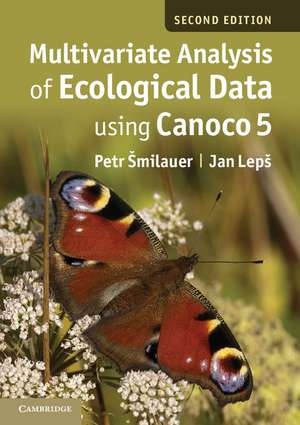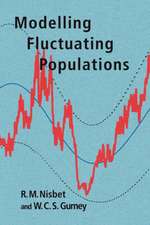Multivariate Analysis of Ecological Data using CANOCO 5
Autor Petr Šmilauer, Jan Lepšen Limba Engleză Paperback – 16 apr 2014
Preț: 495.34 lei
Preț vechi: 556.56 lei
-11% Nou
Puncte Express: 743
Preț estimativ în valută:
94.81€ • 98.60$ • 79.45£
94.81€ • 98.60$ • 79.45£
Carte tipărită la comandă
Livrare economică 14-28 martie
Preluare comenzi: 021 569.72.76
Specificații
ISBN-13: 9781107694408
ISBN-10: 110769440X
Pagini: 376
Ilustrații: 173 b/w illus. 24 tables
Dimensiuni: 175 x 269 x 18 mm
Greutate: 0.73 kg
Ediția:Revizuită
Editura: Cambridge University Press
Colecția Cambridge University Press
Locul publicării:New York, United States
ISBN-10: 110769440X
Pagini: 376
Ilustrații: 173 b/w illus. 24 tables
Dimensiuni: 175 x 269 x 18 mm
Greutate: 0.73 kg
Ediția:Revizuită
Editura: Cambridge University Press
Colecția Cambridge University Press
Locul publicării:New York, United States
Cuprins
Preface; 1. Introduction and data types; 2. Using Canoco 5; 3. Experimental design; 4. Basics of gradient analysis; 5. Permutation tests and variation partitioning; 6. Similarity measures and similarity-based methods; 7. Classification methods; 8. Regression methods; 9. Interpreting community composition with functional traits; 10. Advanced use of ordination; 11. Visualising multivariate data; 12. Case study 1: variation in forest bird assemblages; 13. Case study 2: search for community composition patterns and their environmental correlates: vegetation of spring meadows; 14. Case study 3: separating the effects of explanatory variables; 15. Case study 4: evaluation of experiments in randomised complete blocks; 16. Case study 5: analysis of repeated observations of species composition from a factorial experiment; 17. Case study 6: hierarchical analysis of crayfish community variation; 18. Case study 7: analysis of taxonomic data with linear discriminant analysis and distance-based ordination methods; 19. Case study 8: separating effects of space and environment on oribatid community with PCNM; 20. Case study 9: performing linear regression with redundancy analysis; Appendix A. Glossary; Appendix B. Sample data sets and projects; Appendix C. Access to Canoco and overview of other software; Appendix D. Working with R; References; Index to useful tasks in Canoco 5; Index.
Notă biografică
Descriere
An accessible introduction to the theory and practice of multivariate analysis for graduates, researchers and professionals dealing with ecological problems.










